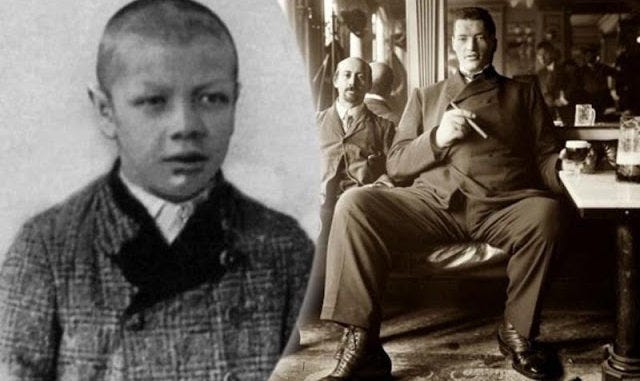Some medical cases are so bizarre that they appear to be straight out of a science fiction novel. The story of Adam Rainer, a dwarf who grew into a giant, is one such example.
Adam Rainer was born in 1899 in Graz, Austria, to average-sized parents. While it may not appear to be relevant, there is no evidence that Dwarfism runs in his family.
He was a healthy baby who grew at a relatively normal rate, according to reports, but little is known about his early life.
Rainer’s illness dominated much of the information gathered about him. At 19, it was clear that Rainer was a dwarf.
When World War I broke out, Rainer enlisted in the army, and at 4ft 6 inches, the army put him through lots of assessments to check his fitness for duty.
Unfortunately, the army rejected him because he was too brief and too frail to be a soldier.
Despite his letdown, Rainer re-enlisted about a year later, having grown nearly 2 inches in that time. However, the army turned him down again because he was not 4’8′′ tall.
The teenager was considered a dwarf because he fell short of the army’s height requirement of 4’10”.
Rainer’s case was intriguing because, despite his short stature, he had unusually large hands and feet for his size.
For example, when he tried to enlist at 19, his shoe size was US 10 or EU 43. However, as Rainer’s physique began to grow, these distinct features began to change.
Rainer’s physical features started to evolve or transform about three years later, and his unusually large hands and feet started growing again.
Most women reach their full height at the age of 18, and most men reach their full height at the age of 21. So there were concerns when Rainer’s feet nearly doubled in size from a size 10 to a size 20.
While the sudden change in the size of his foot and hand was unexpected, he also began to grow taller. Rainer grew to a massive 7’1′′ over the next decade, according to historical sources.
Unfortunately, as a result of his rapid growth, he began to develop spinal curvature. His physical appearance was mysterious, and no one could figure out what was fueling his abnormal growth.
So, in 1930, two doctors named Dr Mandl and Dr Windholz examined Rainer, who was 32 years old and still growing by all accounts.
According to their preliminary findings, they suspected Rainer had acromegaly, a condition most commonly associated with gigantism that is caused by a surplus of growth hormone in the body.
Rainer’s case, on the other hand, is unique in that his acromegaly did not emerge until he was an adult.
A tumor on the pituitary gland, which is located at the base of the brain, causes acromegaly.
This tumor produces an excess of growth hormone, resulting in gigantism or acromegaly. This increase in height occurs in children due to bone lengthening, but it does not occur in adults. As a result, the increase in bone size is restricted to the hands, feet, and face.
Adults frequently experience facial changes such as a protruding lower jaw and brow bone, an enlarged nose, thickened lips, and wider spacing between teeth.
Acromegaly, on the other hand, is rare and can often progress slowly, making it hard to detect.
Many of the symptoms of acromegaly were present in Adam Rainer’s case, including hand, foot, and face enlargement. However, he grew at an alarming rate, resulting in his persistent spinal curvature.
Rainer’s case is unique in that he not only suffered from gigantism as a child but also as an adult. When there is an abnormal increase in height, gigantism is usually diagnosed in childhood.
Rainer’s gigantism, on the other hand, did not appear until he was 18 years old.
His doctors were especially concerned about the curvature of his spine, which seemed to worsen over time. Finally, his worsening condition convinced doctors that removing his tumor was necessary.
They hoped that by removing the tumor on his pituitary gland, they would be able to stop the excess production of Growth Hormone and, hopefully, his uncontrollable growth.
At the doctor’s request, Adam Rainer underwent dangerous surgery to remove a tumor on his pituitary gland.
The surgical team was doubtful that they could eliminate the tumor because it had been expanding for a decade, but they were successful.
They examined Rainer again after a few months and were delighted to see that his standing height had remained largely unchanged; however, his spinal curvature had become more intense.
He was still growing, but much more slowly. Rainer’s health began to deteriorate as he grew older, as is common with acromegaly.
Among his mounting medical issues were blindness in his right eye, hearing loss in his left ear, and crippling headaches.
Finally, Adam Rainer died in his bed on March 4, 1950, at the age of 51, standing 7’8″ tall, making him Austria’s tallest person.
Early diagnosis and treatment are critical for managing this condition; maybe if medical professionals had dealt with Rainer’s situation sooner, he would have lived a more comfortable, and possibly longer, life.

